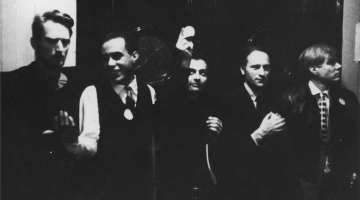I think it’s a good sign that art people can be made uncomfortable in the way Genesis Breyer P-Orridge makes them uncomfortable. S/he doesn’t fit into any category, which is exactly what s/he intends, making the process of h/er recent re-evaluation in art historical context particularly important to analyze. H/er retrospective “S/HE IS HER/E” mounted by the Andy Warhol Museum in Pittsburgh brings together 100 works from the mid 1970s to today; you look back through h/er current “pandrogyny” work, following the evolution of formal strategies (performance, the cut-up) and the expansion of a coherent symbolic vocabulary.
While Genesis is a cult icon in the music world, best know as the animating force behind the bands Throbbing Gristle and Psychic TV, h/er pioneering performances are rarely considered in the lineage of performance art, just as h/er visual art remains largely unexamined. One reason for this is that P-Orridge has done a lot of work to construct h/er own theoretical/philosophical context that is antithetical to the commercial art world and its discourses. H/er voluminous writings have recently been made available in the “Psychick Bible” where s/he discusses different ritual actions one can do to de-naturalize the structures of social and political power that invisibly govern our minds and bodies.
One of these ritual acts of image-making is the “sigil”—a process of symbolic spell making with the intention of “making something happen.” That Breyer P-Orridge insists that its art’s job is to “make things happen” in the world, as a vital part of life, shows how far she is from the academic-careerism that dominates current discourse. A collection of sigils from the 80’s are shown, including one made at the request of h/er friend Derek Jarman who needed strength to finish a film as he was dying of AIDS.
Like any alchemist Breyer P-Orridge wants to regain the “order of intimacy” as Bataille put in in his “Theory of Religion” a state where all categorical divisions have been broken down. Kissing and sex rituals are then figured as a symbolic representations of this merger. In the kinetic sculpture “Tongue Kiss” two wolf heads with knife tongues face each other, one suspended upside-down circling the other. The knife tips pass a hair’s width apart—every so often hitting, making a little ringing sound. It is a beautiful little meditation on the structure of desire. The idea of the cut-up, taken from the artist’s friends Brion Gysin and William Burroughs, comes to its fullest incarnation in the Pandrogyne work where P-Orridge and h/er lover Lady Jaye Breyer “cut-up” their bodies to create a third being.
The most beautiful section of the exhibition is a gallery of Polaroids by Breyer P-Orridge and selection of previously unseen Warhol polaroids. In some ways glamour and outrageous social performance make Genesis-Warhol seem like an easy fit, although they are in fact completely opposites in intention and execution. Unlike Warhol, with his shell game of surrogates, it is actually always P-Orridge’s own body on the line, a body that believes in sex, violence, and spirituality and eschews all the vacant materialism of the Warhol-automaton. Genesis, with the greatest humor, addresses this conflict in the collage “Like Father, Like Son?” All children have to rebel against their parents.
The day before the opening Genesis gave a walk through just for the staff of the museum—almost all of them came, it was a mob. As we were leaving the opening through the back, one of the security guards stopped h/er and said “I want to tell you that what you said about your art was one of the best things I’ve ever heard. We’ve all been talking about it. I think this is the best thing I’ve ever seen at this museum.”
For more information visit heree.
-Contributed by Jarrett Earnest






